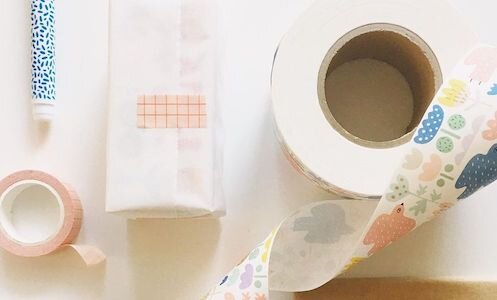As we take a closer look at packaging to ensure it’s plastic-free, an element to consider is one that sometimes gets overlooked – tape.
Tape is a necessary component of packaging in many cases and can be confusing to figure out what the best eco-friendly version is to use. From materials to adhesion, every aspect has to be considered.
Water-activated tape
Water-activated tape is also called “gummed” tape. The adhesive gets activated when it gets wet. Most water-activated tapes are paper-based and are tamper-resistant.
This tape will biodegrade much more quickly than other types of tape and can be recycled completely. The starch-based adhesive easily dissolves and separates in the repulping process. It has a paper face stock, so the face stock itself actually gets recycled along with the corrugated stock of the shipping box.
Something to look out for is reinforced water-activated tape. This type of water-activated tape contains a fiberglass mesh that cannot be recycled and will take decades for the earth to break down. This tape is made by combining two or more layers of pure kraft paper sandwiching glass fiber reinforcement filaments that make this variety of tape much stronger and capable of sealing heavy packets. So although it may work for sealing higher weight packages, it’s not the eco-friendly way to go.
Kraft flatback tape
Kraft flatback tape has a paper-based face stock. The adhesive on this tape however does not separate from the face stock or the corrugated box as easily as Water Activated Tape during the repulping process. What usually happens with this tape is the adhesive is separated during the remanufacturing process and then landfilled, so this is not as eco-friendly as water-activated tape.
Cellulose Tape
Cellulose, along with lignin, is one of the main chemical components of wood. Thus, although it may look like petroleum-based plastic, this tape is made from trees. However, both the face stock and adhesive are non-paper and would be screened out in the repulping process and then landfilled. It also takes longer to break down in landfills than paper tape.
Masking Tape
Masking tape is one of the handiest types of tape out there. At first glance, this looks like paper tape, however, not all masking tape is recyclable like other paper tapes.
Some masking tape products are made from recycled materials, so it cannot be recycled again. This is a cause for debate as to whether or not it is eco-friendly because you’re either using a recycled product, or your product can be recycled. However, it’s not the most eco-friendly option overall. If you are using masking tape, it’s a good idea to get the kind that is recyclable. This kind of tape should be clearly marked with a recycling symbol.
Tapes to Avoid
When possible, tapes to consider avoiding in general for eco reasons include- duct tapes, washi tape, and plastic, sticky tape.
Eco-friendly Options
Overall, when you’re going for eco-friendly and plastic-free, a water-activated tape is the way to go. There are many options out there for this, for example, the company noissue launched a custom packaging tape that is compostable and printed on FSC Certified paper, that uses a starch-based adhesive that activates when wet.
Have other favorite eco-friendly tapes? Let us know!





